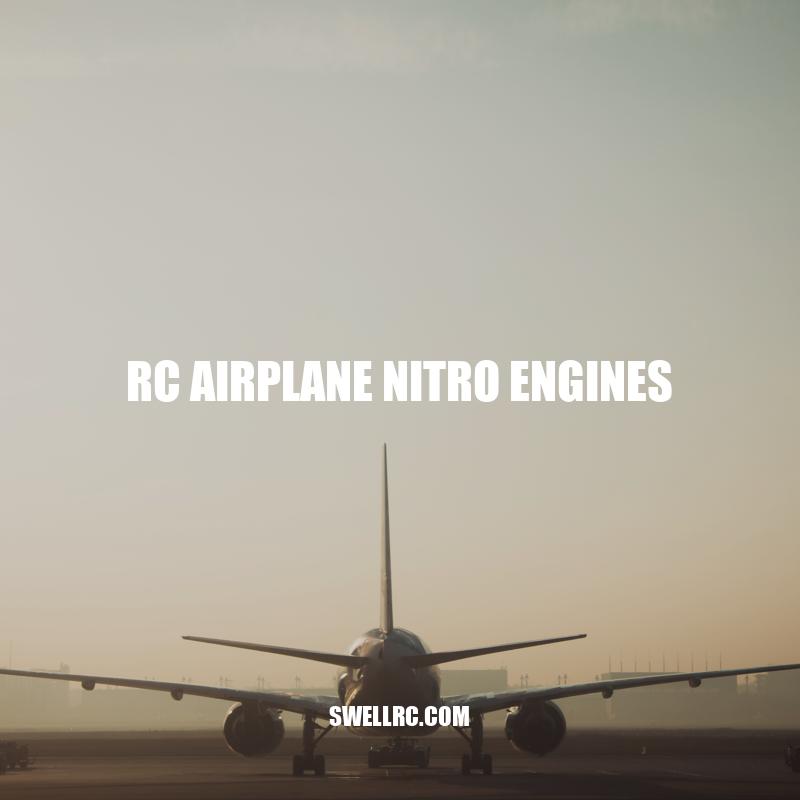RC Airplane Nitro Engines: Power and Performance at Your Fingertips
RC airplane nitro engines are sensational. They produce the power and speed required by RC enthusiasts to perform amazing stunts and maneuvers. These engines run on a mixture of nitromethane, methanol, and oil. Nitro engines require glow plugs to ignite the fuel mixture and maintain combustion. Compared to other types of engines, nitro engines have a high power-to-weight ratio, making them an excellent choice for RC airplanes. Nitro engines can provide astonishing power, allowing for quick acceleration, incredible speed and an exhilarating flying experience. The engines produce a signature sound that most plastic electric RC airplanes can’t mimic. Their exhaust emits fumes that also contribute to their unmistakable odor and add to the performance of the RC airplane. Even with advancements in electric motors, nitro engines remain popular. However, these engines require proper maintenance and handling to ensure long-lasting and satisfactory performance.
Types of RC Airplane Nitro Engines
RC airplane nitro engines are broadly classified into two categories, two-stroke, and four-stroke engines. The type of engine used in an RC airplane determines power output, speed, and fuel efficiency. Here are the differences between the two types of engines:
- Two-Stroke Engines
- Burn fuel every other stroke
- Are lighter and more popular
- Provide higher RPMs
- Four-Stroke Engines
- Burn fuel every fourth stroke
- Are more fuel-efficient
- Provide a smoother, more consistent power output
Determining which nitro engine to use in an RC airplane depends on the pilot’s preference, the size of the airplane, flying style, and type of RC airplane. In the market, there are many nitro engines to choose from, some of the most popular being the DLE Engines, O.S. Engines, and Saito Engines. These engines have a proven performance record and are reliable when properly maintained. Successful nitro engine operation requires tuning, regular maintenance, and keeping track of the engine’s performance log. In the next section, we’ll cover the pros and cons of nitro engines.
What are the 2 engine categories?
There are two main categories of engines: internal combustion engines and electric motors. Here is a brief description of each:
- Internal Combustion Engines: These engines are powered by combustion of fuel and air inside a combustion chamber. Examples of internal combustion engines are gasoline engines, diesel engines, and hybrid engines.
- Electric Motors: These engines are powered by electricity and use either AC or DC power to create rotational force. Examples of electric motors are found in electric vehicles, industrial machinery, and household appliances.
Understanding the differences between these two engine categories can be useful in various industries, including automotive, manufacturing, and energy. For more information on specific engines, visit websites such as Car and Driver or Popular Mechanics.
RC airplane nitro engines have both advantages and disadvantages. One of the primary pros is their high power-to-weight ratio, which allows them to provide exceptional power while remaining lightweight. This makes it possible to achieve impressive speeds in the air. The realism they bring to the flying experience is also a significant advantage for many remote-control enthusiasts. Using a fuel-efficient nitro engine can prove to be cheaper compared to gasoline ones. Starting and operating nitro engines is also relatively easy.
However, a disadvantage of using nitro engines is that they require regular maintenance and tuning to maintain optimal and efficient performance. Nitro engines also generate a significant amount of noise and produce exhaust fumes, which can be a distraction during flights. As a result, nitro engines aren’t suitable for indoor flying due to noise and fumes.
Despite these challenges, many remote-control enthusiasts prefer nitro engines due to their dynamic and realistic flying experience. If you’re interested in purchasing a nitro engine for your RC airplane, some of the top brands include OS Engines, Saito, and Tower Hobbies.
What are the cons of nitro or gas powered RC planes?
| Cons |
|---|
| Higher maintenance required compared to electric RC planes |
| Messier fuel and exhaust emissions |
| More expensive to maintain and operate |
If you’re looking for a lower maintenance and cost option for RC planes, electric planes may be a better choice for you. But if you enjoy the sound and realism of a gas or nitro-powered plane, there are still plenty of options available.
Check out websites like Horizon Hobby or Tower Hobbies for a variety of RC planes and information on maintenance and operation.
Choosing the right nitro engine for an RC airplane can be a daunting task. Here are a few factors to consider before making a purchase:
- The size of the airplane
- The type of RC airplane
- The style of flying
- The power output of the engine
- Fuel consumption
- Operating costs
- Ease of use and handling
It’s important to choose an engine that is powerful enough to lift the airplane and provide optimal speed. Fuel consumption and operating costs can also influence your decision, as some engines may burn fuel more efficiently than others. Your experience level and flying style are essential considerations as well. For instance, those who enjoy acrobatic maneuvers may want an engine that produces high RPM and power.
Ease of handling and use is another critical factor to consider when selecting a nitro engine. Look for an engine that is relatively easy to start and operate, has minimal vibrations, and runs smoothly. Websites such as Horizon Hobby and Tower Hobbies are excellent resources to find a variety of nitro engines for RC airplanes.
Considering these factors will help you choose the best nitro engine for your RC airplane, ensuring you enjoy optimum performance and a realistic flying experience.
How do I choose the right motor for my RC plane?
Choosing the right motor for your RC plane is crucial to its performance and endurance. Some factors that need to be considered are:
- Weight and size of the aircraft
- Wing area and type of airfoil
- Desired flight time and power requirements
- Battery capacity and voltage
- Propeller size and pitch
To simplify the process, many websites offer motor recommendations based on the specific characteristics of your plane. Some popular websites that offer this service include:
- rcgroups.com
- hobbyking.com
- towerhobbies.com
It is important to note that while these recommendations can be helpful, they should not be considered the ultimate solution. It is always important to do your own research and experimentation to find the perfect motor for your RC plane.
Nitro engines require regular maintenance to ensure optimal performance and prolong lifespan. Here are a few simple tips for maintaining nitro engines:
- Monitor and maintain the proper fuel mixture for the engine.
- Clean the air filter regularly to ensure proper airflow to the engine.
- Lubricate moving parts regularly to prevent excessive friction and wear.
- Check the fuel lines for leaks and damage.
- Store the engine correctly in a dry, cool place to prevent rust and corrosion.
- Replace damaged or worn-out parts as needed.
Proper maintenance and upkeep of the engine can significantly improve its lifespan and ensure consistent performance. It’s also crucial to ensure you are using high-quality fuel and lubricants specifically designed for RC airplane engines. Regular replacement of fuel lines, glow plugs, and air filters is essential to prevent engine failure and damage.
Websites such as Amazon and eBay provide an excellent selection of nitro engine maintenance products, including lubricants, air filters, fuel lines, and glow plugs. It’s crucial to purchase genuine parts and lubricants, as generic products may harm your engine’s performance and longevity.
Overall, proper maintenance of nitro engines is critical in ensuring optimal performance and prolonging the lifespan of the engine. By following the tips above and keeping the engine in good working condition, you can enjoy many hours of realistic flying experience with your RC airplane.
How do you maintain a nitro engine?
To ensure optimal performance, it is important to regularly maintain your nitro engine. Here are some basic tips to follow:
- Change the air filter after every few runs or when it starts to look dirty.
- Keep the engine clean and free of debris.
- Check the fuel lines for cracks or leaks and replace if necessary.
- Use high-quality fuel and filter it before filling the tank.
- Store your nitro car with the fuel tank empty to prevent engine damage.
For more detailed information, you can check out online forums or websites dedicated to nitro engines. Products such as engine cleaners, fuel filters, and air filters are also available for purchase to help with maintenance tasks.
Conclusion
In conclusion, nitro engines remain a popular choice for powering RC airplanes, providing incredible power, speed, and realism to the flying experience. When selecting a nitro engine, it’s crucial to consider factors such as the size of the airplane, fuel consumption rate, and operating costs. Additionally, proper maintenance and upkeep of the engine are essential to ensure optimal performance and prolong the lifespan of the engine. Regular cleaning, lubrication, and part replacements are critical to preventing engine failure and damage. By following the tips outlined in this article, you can improve the performance and longevity of your nitro engine. Don’t forget to purchase high-quality fuel, lubricants, and parts to ensure consistent engine performance. With proper maintenance and efficient operation, you can enjoy many hours of exhilarating flying experience with your RC airplane nitro engine.



